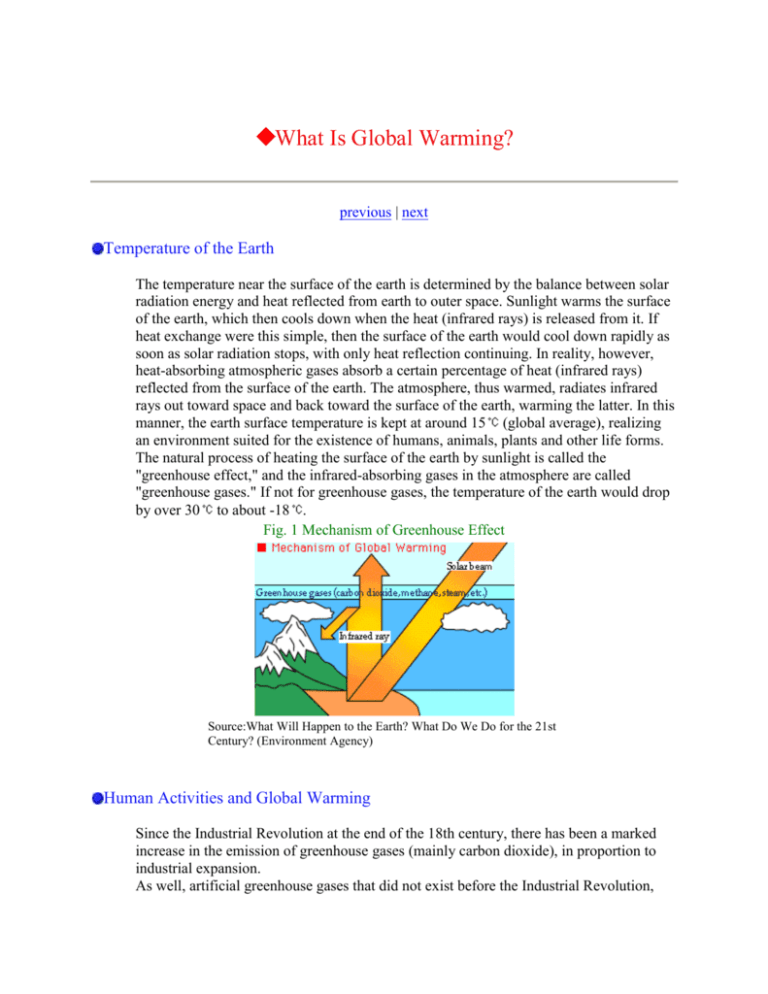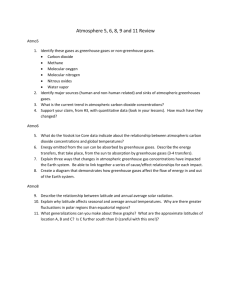What Is Global Warming
advertisement

What Is Global Warming? previous | next Temperature of the Earth The temperature near the surface of the earth is determined by the balance between solar radiation energy and heat reflected from earth to outer space. Sunlight warms the surface of the earth, which then cools down when the heat (infrared rays) is released from it. If heat exchange were this simple, then the surface of the earth would cool down rapidly as soon as solar radiation stops, with only heat reflection continuing. In reality, however, heat-absorbing atmospheric gases absorb a certain percentage of heat (infrared rays) reflected from the surface of the earth. The atmosphere, thus warmed, radiates infrared rays out toward space and back toward the surface of the earth, warming the latter. In this manner, the earth surface temperature is kept at around 15 (global average), realizing an environment suited for the existence of humans, animals, plants and other life forms. The natural process of heating the surface of the earth by sunlight is called the "greenhouse effect," and the infrared-absorbing gases in the atmosphere are called "greenhouse gases." If not for greenhouse gases, the temperature of the earth would drop by over 30 to about -18 . Fig. 1 Mechanism of Greenhouse Effect Source:What Will Happen to the Earth? What Do We Do for the 21st Century? (Environment Agency) Human Activities and Global Warming Since the Industrial Revolution at the end of the 18th century, there has been a marked increase in the emission of greenhouse gases (mainly carbon dioxide), in proportion to industrial expansion. As well, artificial greenhouse gases that did not exist before the Industrial Revolution, such as CFC (chlorofluorocarbon) and sulfur hexafluoride, have been produced, and are being released into the atmosphere. Increased greenhouse gases destroy the heat exchange balance, keeping greater amounts of heat in the atmosphere and on the earth (i.e. intensifying the greenhouse effect) and raising the temperature near the surface of the earth to undesirable levels. This phenomenon is called global warming. Greenhouse Gases Carbon dioxide Carbon dioxide is a greenhouse gas that has been increasing remarkably, mostly as a result of the combustion of fossil fuels such as coal, petroleum and natural gas. The atmospheric concentration of carbon dioxide, which was about 280 ppmv (ppmv is a unit for ratio of volume in parts per million) before the Industrial Revolution, has reached 358 ppmv (about 1.3 times) in 1994. If no other measures than those taken at present are introduced, the figure is expected to reach 500 ppmv in 2050 and 700 ppmv in 2100, and to continue to increase for many centuries to come. The atmospheric concentration of carbon dioxide can be stabilized by controlling, on a global scale, artificial carbon dioxide emissions to a level sufficiently below the present level. Fig. 2 Atmospheric Concentration of Carbon Dioxide and Contribution of Greenhouse Gases to Global Warming Atmospheric carbon dioxide concentration Contribution to global warming by greenhouse gases from human activities (1992) Source:What Will Happen to the Earth? What Do We Do for the 21st Century? (Environment Agency) Methane Methane forms naturally in swamps, lakes and marches, and is also generated as a result of human activities such as livestock farming, paddy field cultivation and underground disposal of waste materials. The atmospheric concentration of methane increased from about 700 ppbv (ppbv is a unit for ratio of volume in parts per billion) before the Industrial Revolution to some 1,720 ppbv (about 2.5 times) in 1994, as human activities have expanded. Although low in concentration, methane accounts for about 20% of contribution to global warming by greenhouse gases, in consideration of the 20-year total sum of its intensity of greenhouse effect (global warming index), based on the fact that its atmospheric residence time is 56 times longer than that of carbon dioxide. CFC (Chlorofluorocarbon) CFCs are artificial gases that did not exist in nature before the Industrial Revolution. They have been in wide use as coolant gases in air conditioners and refrigerators, and as industrial cleansing agents. In recent years, CFCs have come to be known as an ozone layer destroyer, but they are also greenhouse gases. CFCs known as "alternative CFCs," which deplete the ozone layer less, or not at all, are, however, greenhouse gases. For example, the greenhouse effect intensity of an alternative CFC called HFC 134a is about 3,400 times that of carbon dioxide in terms of 20-year total effect, based on its atmospheric residence time. For this reason, despite their small volume, such gases account for about 10% of contribution to global warming by all greenhouse gases. Nitrogen suboxide Nitrogen suboxide is a byproduct of the combustion of organic substances and nitrogen fertilizers. The atmospheric concentration of nitrogen suboxide, about 275 ppbv before the Industrial Revolution, had increased to 312 ppbv by 1994 (about 1.1 times). The intensity of its greenhouse effect (global warming index), in terms of the 100-year total effect based on its atmospheric residence time, is 310 times that of carbon dioxide, but its contribution to global warming is only abut 6% because of its low concentration.









